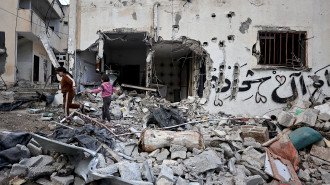
Could Israel's Iron Beam laser system be a military game-changer in the Middle East?

Israel’s Rafael Advanced Defence Systems expects its much-hyped Iron Beam laser defence system will enter service next year.
“Iron Beam is just one of the developments that is progressing at a nice pace, and it has global technological breakthroughs,” Rafael CEO Yoav Tourgeman recently told Israeli media.
A Rafael official confirmed to Breaking Defence in March that the company expects the laser system to enter service “by the end of 2025”.
Both officials were talking about the ground-based version of the Iron Beam. There is also an airborne version Israel is working on, but it’s expected that will take years to develop.
In August, Fitch Ratings, the American credit rating agency, predicted that “the conflict in Gaza could last well into 2025 and there are risks of it broadening to other fronts”.
If the Gaza conflict and concurrent regional clashes do continue that long, the Iron Beam may make its combat debut shortly after its introduction into service.
The laser system will complement its predecessor, the well-known Iron Dome, which has intercepted thousands of Hamas projectiles since its introduction over a decade ago.
Big shoes to fill
“The Iron Beam has the potential to reduce costs and improve the effectiveness of Israel’s short-range defences at scale, but it still needs to live up to its hype in real combat,” Ryan Bohl, a senior Middle East and North Africa analyst at the risk intelligence company RANE, told The New Arab.
“Iron Dome is already relatively effective at intercepting projectiles, and while Iron Beam will drive down the costs of such defences, that doesn’t necessarily mean that it is a game changer for the conflicts occurring on Israel’s near frontier,” Bohl said.
The Iron Beam will complement rather than supplant the Iron Dome. Nevertheless, it must first match the Iron Dome’s impressive interception rate to distinguish itself from its battle-tested predecessor.
“Most reports suggest that Iron Dome is already 80 to 90% effective,” Bohl said. “So, for Iron Beam to be a game changer, it would need to be well above that 90%,” he added.
“Moreover, when Iron Dome fails, it’s often because other systems or there’s human error failures make it so this already relatively effective system isn’t deployed properly. Iron Beam in and of itself won’t overcome those constraints to its effectiveness.”
Federico Borsari, a defence expert at the Centre for European Policy Analysis, described Iron Beam as “an important addition to Israel’s air and missile defence umbrella”, especially against short-range threats like rockets, mortars, and drones.
|
|
He highlighted some advantages of the system, such as its cost-effectiveness “in terms of cost-per-interception” compared to the Iron Dome and its “relatively cheap” Tamir interceptor missiles. The Iron Beam “will cost a few dollars per shot compared to tens or hundreds of thousands of dollars per unit (at a minimum)” for the Iron Dome.
Furthermore, unlike the Iron Dome, the Iron Beam will have “virtually infinite magazine depth” and a “near-instantaneous target engagement time” of barely a few seconds.
Nevertheless, the CEPA analyst also highlighted three significant limitations.
“First, the ability to deal with one single target at a time compared to the multi-target engagement capabilities of traditional air and missile defence systems,” Borsari told TNA.
“Second, its cooling requirements, which make it more suitable for defending stationary targets (infrastructure, military sites, etc.), although manufacturers are working on a manoeuvre version and even an airborne one,” he added.
“Third, the susceptibility to environmental conditions, especially cloudy sky or limited visibility, although it may be a minor problem in Israel.”
Borsari also anticipates the Iron Beam will complement Israel’s broader air defences rather than replace them in the long term.
“The Iron Beam will form one of the layers of a diversified defensive umbrella that includes both active and passive countermeasures and effectors,” he said.
Rules of engagement
The Iron Beam’s introduction will likely have some impact on calculations made by groups like Hezbollah in its skirmishes with Israel.
The Lebanon-based group has long calculated that it could overwhelm Israeli air defences with enormous rocket barrages in the event of an all-out war. Hezbollah’s arsenal of surface-to-surface missiles and rockets is estimated to number over 100,000.
Bohl anticipates that Hezbollah may conclude it will “need a larger barrage than in the past to overcome the potential technical advantages of an Iron Beam system” if it remains intent on overwhelming Israel’s air defences.
However, such presumptions could also result in fatal blunders of the kind that unwittingly spark wars.
Bohl explained that Hezbollah could become convinced the Iron Beam has significantly strengthened Israeli defences. Therefore, the group may conclude that launching more extensive rocket attacks against central Israeli cities to send a political message would be less risky than before.
However, if the Iron Beam “isn’t necessarily effective enough” to intercept such attacks, that could result in civilian casualties, which would “definitely drive escalation.”
CEPA’s Borsari doubts the Iron Beam would change the rules of engagement between Israel and Hezbollah.
"Iron Beam will undoubtedly enhance Israel's air defences but not fundamentally transform them"
“I don’t think it will fundamentally change the security calculus in the area, although it will certainly strengthen Israel’s air defences, provided it is integrated in sufficient numbers,” Borsari said.
“The Iron Beam is not a wonder weapon, so it will not alter the rules of engagement,” he added. “But it will certainly force Hamas and Hezbollah to reconsider their tactics to successfully penetrate Israel’s defences as rockets and drones will face additional countermeasures.”
While the ground-based version of the Iron Beam could prove suitable for countering threats in Israel’s immediate vicinity, an airborne version could help against specific threats further afield, such as the Houthis in Yemen. An Israeli F-35 shot down a Houthi cruise missile with an air-to-air missile last year. Such missiles can cost hundreds of thousands or even $1+ million each.
“On paper, an air version (which is under development) would allow the air platform carrying the laser payload to intercept aerial threats at a fraction of the cost of traditional air-to-air missiles, although it will still have the single target engagement limitation,” Borsari said. “But when complemented by other effectors, it will be a useful addition to the capability set,” he added.
“The airborne version, however, will take some time before its deployment.”
RANE’s Bohl also expects it will take time before such a capability is developed.
“I think we’ll be waiting a while before we start to see directed energy weapons being capable of running such interception missions at scale,” he said. “After all, interceptions with missiles that can correct course is a key part of their effectiveness, and a directed energy blast can’t do that.”
'Niche capability'
Iron Beam will undoubtedly enhance Israel’s air defences but not fundamentally transform them.
“The Iron Beam will certainly be effective, but it is a specific, niche capability for a specific target set,” Borsari said. “While it can engage different types of targets, it must be integrated with other capabilities and cannot operate alone. The magazine depth is certainly important, but its limitations need to be considered.”
The system will make it more difficult for rockets and drones to penetrate, but in the defence and technology fields there is rarely a definitive solution, the CEPA analyst said.
For example, Israel has a superior technological edge over Hamas which includes sensors and state-of-the-art robotic sentry turrets.
“Yet, Hamas militants were able to deceive and evade these technologies and catch Israel by surprise,” Borsari said.
Paul Iddon is a freelance journalist based in Erbil, Iraqi Kurdistan, who writes about Middle East affairs.
Follow him on Twitter: @pauliddon
![Hezbollah has been careful not to escalate beyond minor skirmishes [Getty].](/sites/default/files/styles/large_16_9/public/2024-06/GettyImages-84235679.jpg?h=199d8c1f&itok=r6r0RFxP)
![Palestine sat next to member states at the United Nations General Assembly on Tuesday [GETTY]](/sites/default/files/styles/image_684x385/public/1441455581.jpeg?h=199d8c1f&itok=CgJaFY6v)





